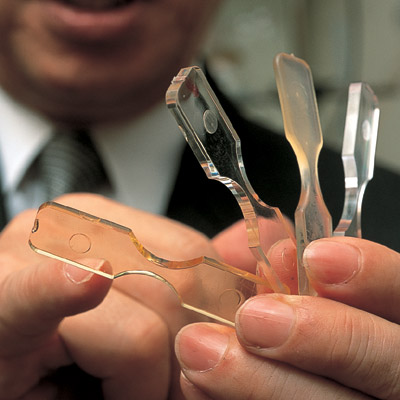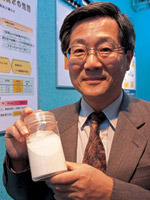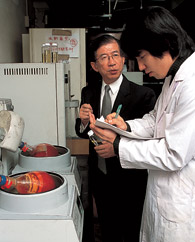 |
|
NIPPONIA No.20 March 15, 2002
|
|
Special Feature*
Chemical Reduces Highly Toxic Dioxin Emissions
Miyoshi Oil & Fat Co., Ltd.
|
Dioxin emissions from garbage incinerators became a matter of great concern in Japan around 1995.
That was when Miyoshi Oil & Fat Co., Ltd., began exploring ways to greatly reduce emissions of that highly toxic substance. Before then, the company had been making a chemical used to remove heavy metals from incinerator smoke and factory wastewater. The company successfully developed a dioxin inhibitor in the autumn of 2001.
The chemical inhibitor is injected into the incinerator flues, where the temperature measures anywhere from 500 to 900 °C. The inhibitor reacts with the heat to reduce smoke and cinders to harmless substances.
Moriya Masafumi, the head of the company's Oil Chemicals Division, says, "Dioxin is a chlorine compound, so our idea was to develop a reducing agent that could remove the chlorine from incinerator emissions. That would prevent the formation of dioxin in the first place."
But finding a substance that could do this was not easy. First they experimented with a number of organic substances, but the ones that reduce chlorine are extremely toxic themselves. So they began examining inorganic substances, and finally found what they were looking for.
Newspapers picked up the story, and since then the company has received plenty of requests for information from local governments and the companies that incinerate their garbage.
|
 |
Kawashima Masatake, head of the Marketing Department, holds a sample of the company's dioxin inhibitor.
|
|
Self-repairing Plastic Can Cut Down on Garbage
Takeda Kunihiko, professor at the Shibaura Institute of Technology
|

Plans call for products made of this self-repairing plastic to be marketed around the fall of 2002.
|
 |
Professor Takeda Kunihiko says that some of our knowledge of living organisms can be applied to non-living things.
|
A Japanese inventor has developed a fascinating type of plastic that "senses" each time it deteriorates a little. Then it repairs itself. You could almost say that the plastic is alive! Takeda Kunihiko calls his invention "self-repairing plastic."
"When a person makes something, the idea is to make it strong enough so that it won't break. Living things can heal themselves when they are injured, because they have protective mechanisms that keep them in shape every day. My idea was to develop a non-living material that could repair itself like a living one."
Takeda's world of artificial self-repair is a world dealing in nanometers. One nanometer (abbreviated nm) is one-billionth of a meter. His plastic contains tiny portions of a catalyzer, each one measuring a mere 0.8 nm, and these are placed at intervals of 5 nm from each other. These tiny "repairmen" move about freely within their own range. When they find a molecular break, they initiate a chemical reaction that seals it back together.
Because the plastic keeps repairing itself, deterioration occurs much less often. "Conventional plastic has an average lifespan of five years or so, but self-repairing plastic won't deteriorate for 20 or 30 years."
Takeda hopes that his invention will help reduce the amount of plastic that ends up being thrown away. 
|
 |


